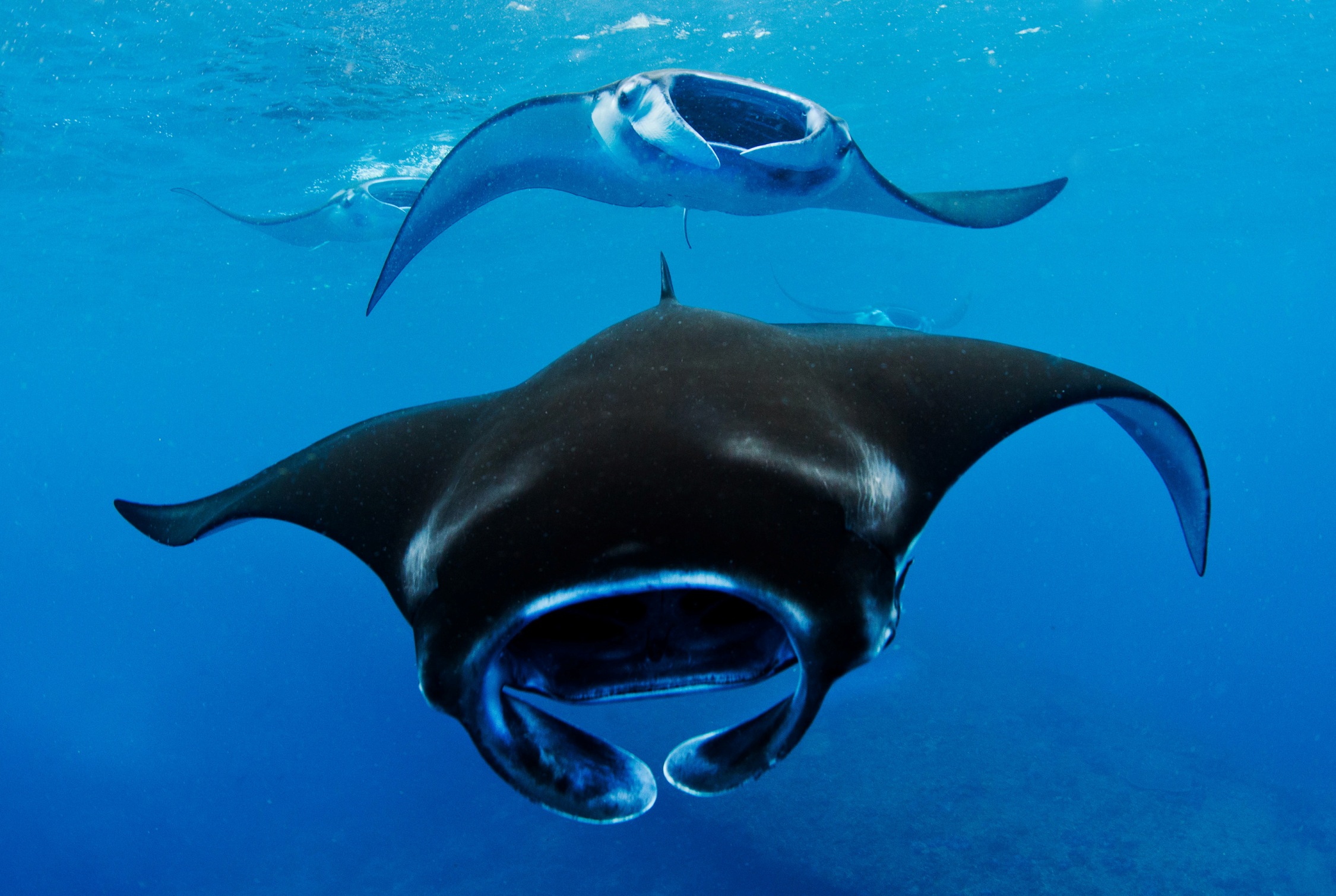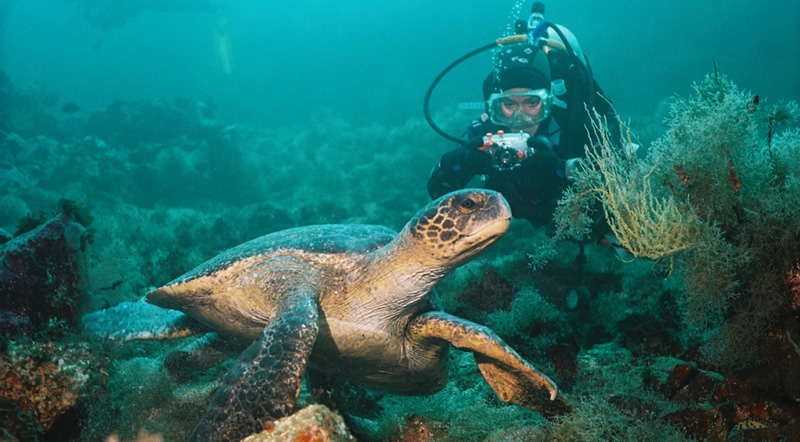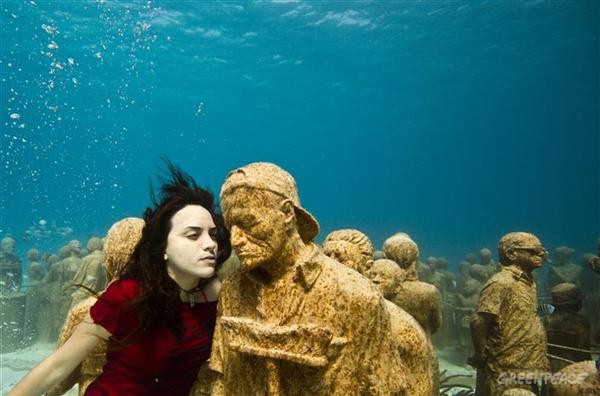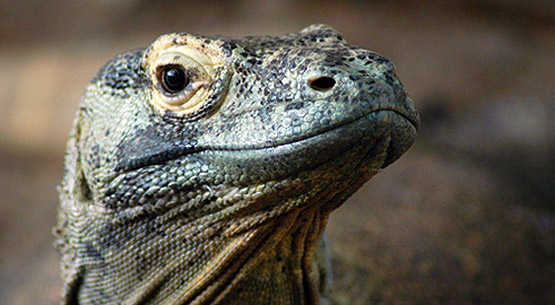By Gavin Parsons
“What has a wingspan of up to seven metres?” That was a question in a pub quiz last week and I’m the only one who got it right. Some guessed condor, others golden eagle, but while these birds are impressive they are never going to beat the correct answer – the manta ray.
Actually that’s not really correct now because scientists have changed the classification of the manta and there are now two, possibly three species, where once there was one.
The giant oceanic manta ray retains the scientific name Manta birostris, but the slightly smaller Manta alfredi or reef manta ray was classified after studies of manta rays across the world.
Most divers still call them “Bloody hell did you see that manta!” and whether it was a reef or oceanic doesn’t seem to matter. Just to let you know though the reef manta grows to roughly 5 metres from wing tip to wing tip and the oceanic manta grows to about seven metres wing tip to wing tip. Both, you’ll agree, are impressive creatures.
Mantas are my favourite animal on the planet. That’s why I knew the quiz answer. They are the embodiment of grace; a marine ballet dancer that make the Bolshoi company look like a bunch of dads dancing at a wedding to Agadoo.
Diving with manta rays usually occurs at cleaning stations. The rays like to visit certain places to get a groom from cleaner fish – wrasse and butterflyfish. Mantas can only hover for a few seconds because they need water passing across their gills to breathe. A stationery manta is the same as a human with their head in the water. That’s because mantas evolved differently to other rays as their mouths face forwards so they can force water laden with tiny creatures across their gills. The majority of other rays – sting rays for example – are able to rest on the seabed and still breathe.
To get close to a manta ray is one of the easiest things to do while diving. You just do nothing. If you see a manta, just stop and wait. They are curious fish with a complex vein and artery structure in their brains called rete mirabile by men in white coats, but it translates from Latin as ‘wonderful net’. It is thought to keep the manta’s brain warm and creates slightly higher brain function than your average fish and has made mantas more inquisitive.
So if you stay still and calm, the ray will more often than not, come to you. One thing guaranteed to turn a manta away though is being chased. There is a very good reason why during their dive brief guides tell divers to remain still and not to approach a manta ray. It is not to be over zealous, but to let you get close to a manta. I still can’t believe the stupidity of some people who’s first and only instinct is to swim at ray. Not only does it ruin the experience for them, but also for everyone else.
I remember seeing a dive guide grab an errant diver who seemed to want to chase after every manta that arrived at the cleaning station. He was not allowed in the water on any of the manta dives after that. So to get within touching distance and take your dive from an “oh, we saw a manta” to “OMG that manta was awesome it came right over my head, I could have reached out and touched it,” is simply a case of staying still and watching the manta to see what it does. Chance’s are you will get close to a manta ray while diving by doing nothing.
Diving with mantas is one of the most satisfying things a person can do in the water. It’s impossible to describe the feeling of watching a massive fish the shape of a stealth bomber coming into vision. It’s akin to watching your child ride a bike for the first time or finding a winning lottery ticket. In fact, I often use the phrase ‘like watching a manta ray swim passed’ as a way to describe the feeling of something awesome.
As with most special things in life, swimming with mantas doesn’t happen just everywhere. However, there are a few locations where diving with mantas is common. Luckily Planet Dive Holidays offers trips to many of them.
Maldives
Perhaps the most popular manta location is the Maldives. These oceanic islands are a mecca for manta spotters as the resident population of manta rays move around the Atolls depending on the season. The Maldives’ weather is influenced by monsoons and the mantas migrate from one side of the atolls to the other depending on which direction the wind comes from. The behaviour is predictable and so the mantas can be found.
While manta dives are available from some of the Maldives Island resorts, the best way to encounter mantas is from a liveaboard. Maldives Liveaboards are a great way to see the islands and find the best manta ray dive sites. Generally the manta diving in the Maldives is around cleaning stations.
When the current and plankton blooms amalgamate you can find manta rays feeding. This situation is best experienced while snorkelling so it is a good idea to keep a mask and snorkel on your main boat just in case (In the Maldives your dive kit is held on a smaller Dhoni, which takes you diving).
To see the opportunities to dive the Maldives see http://www.planetdiveholidays.com/countries/maldives/mdv
Yap
In the echelons of diving, there are some destinations which hold higher esteem than others. Places such as the wrecks of Truk Lagoon or the shark shoals of Cocos for example. They are dream diving destinations that stand head and shoulders above the rest. Well there is a destination in that honey pot just for mantas. Yap is a small island in the tropical South Pacific Ocean. So small is it, you’d be hard pushed to find it on a map. Yet in manta ray diving circles, it is something of a Holy Grail. Yap’s economy is reliant on its manta ray population and the regularity of sightings. From December to April the mantas of Yap inhabit the M’il Channel and are seen pretty much every day. As you find out when diving with the Manta Ray Bay Resort, Yap’s diving is awesome without the mantas, but with them it is a world class dive destination. Not bad for an island that still uses stone money in some parts of the economy.
To find out more about Yap’s diving visit: http://www.planetdiveholidays.com/resorts/micronesia/yap/
Hawaii
Hawaii is the destination of Magnum PI, Volcanoes and shirts so bright you can see them from the moon (I may have exaggerated that), plus a bit of surfing culture. It’s also the place for one of the most unique dives on the planet. Just off the Island of Kona is a dive so spectacular that it has earned the whole island worldwide fame. I said before most manta dives are around cleaning stations. Well Kona has a manta feeding station. The rays discovered many years ago that bright lights attract plankton in great clouds. Divers discovered this while night diving close to one of the beachside hotels which had bright lights aimed at the surface. They came across mantas feeding on the plankton swarm and a new night dive was born.
Kona’s manta ray night dive is one of the best dives in the world. It is an experience unmatched by the human entertainment industry. Perhaps if you mixed the lightshow of light composer Jean Michel Jarre with the piano grace of Ludovico Einaudi (listen to any BBC link video) and let Darcy Bussel dance to it while wing walking on a glider across the Grand Canyon you may get close to the slap in and face beauty of this dive.
To find out more about diving Kona see: http://www.planetdiveholidays.com/liveaboards/vessels/usa-(incl.-hawaii)/usa/kona-aggressor-ii/623
Galapagos Islands (Cabo Marshall)
Manta rays like current and the Galapagos have them in abundance. So while you can dive with manta rays around the Galapagos, the one with the most frequent sightings is Cabo Marshall. This site lies off the north eastern shore of Isabella Island and is frequented by massive shoals of fish.
Galapagos liveaboards stop in the area when they dive Wolf Island and Darwin Island.
The plankton rich water also attracts giant oceanic mantas, which are often sighted. These leviathans are the largest winged animal on the planet. As they come flapping into view you need to make sure your regulator doesn’t fall out as your jaw drops open. Diving with giant mantas is a belittling experience. On land in our every day lives humans are not dwarfed by many things. Walk down the street of your local town and there is nothing to make you feel insignificant except perhaps a lorry driving too close to the pavement. Being in the water with a giant oceanic manta induces the same sort of feeling, except they are harmless giant wanderers who deserve fascination. Often inquisitive, they can approach very closely.
To find out more about diving Kona see: http://www.planetdiveholidays.com/liveaboards/itineraries/ecuador-galapagos/ecu
Fiji
Fiji’s Kadavu island is one of those places with a site called Manta Reef. There are lots of them around the world. They go alongside Shark Point, Stingray Alley and the like. What makes Kadavu’s Manta Reef different is it actually holds mantas. Kadavu’s manta rays are of the Giant Oceanic variety and some are more black than black and white. So even if you have seen mantas before, Fiji’s manta ray diving is a new experience. You can dive Manta Reef from the stunningly beautiful Matana resort, which rus regular dive trips to this reef and many others around Kadavu.
Fiji’s manta rays use Manta Reef as a cleaning station and visit daily to get parasites removed. Diving Fiji’s Manta Reef is a pleasant experience in itself as it is close to Astrolobe Reef, one of the world’s most famous dive sites, but when a creature the size of a small aeroplane flies in from the ocean or across the top of the reef it sets the pulse racing.
The giant creatures find areas holding cleaner fish and hover for a few seconds. They then have to move to keep oxygenated water flowing across their gills and they circle around. That’s when they may come close as they try and find out what the bubble-blowing creatures are.
To find out more about Kadavu and Fiji diving see: http://www.planetdiveholidays.com/resorts/fiji/kadavu-island/



